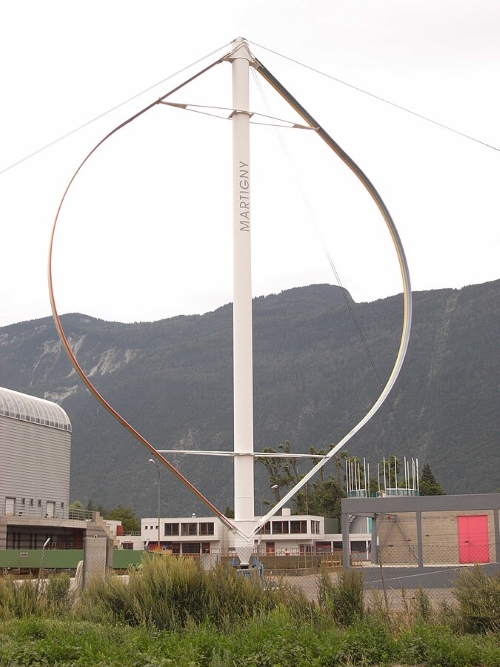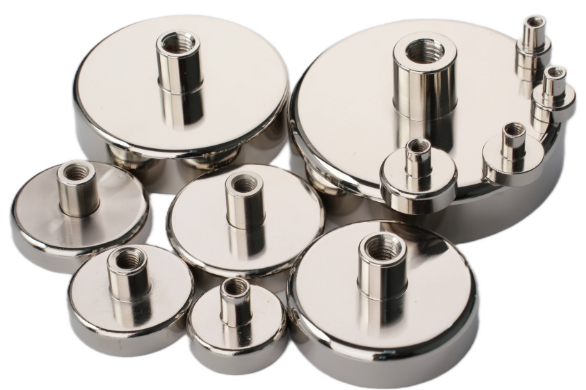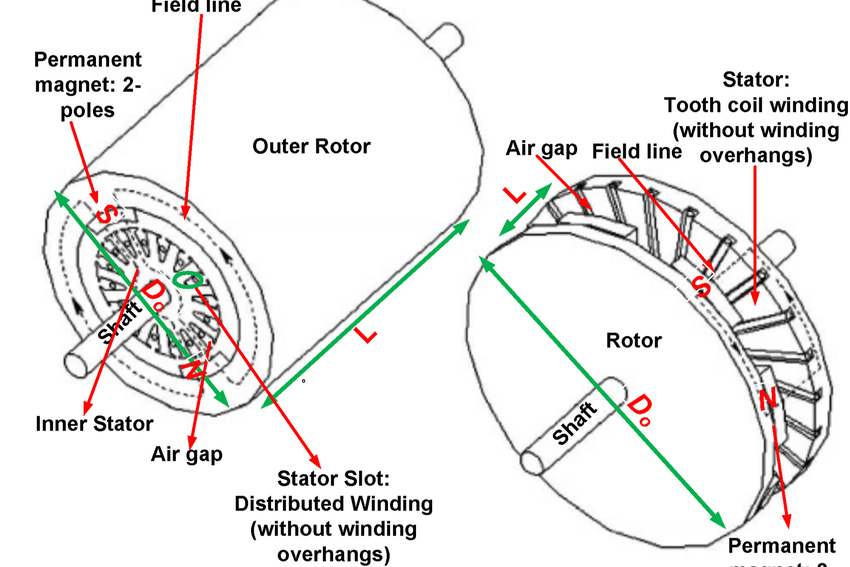Wind Turbine Magnets: A Comprehensive Guide with Cases
Introduction
Wind turbines have become essential to renewable energy infrastructure, providing clean, sustainable power to meet the growing global demand. Magnets, particularly permanent magnets, play a crucial role in improving the efficiency and performance of wind turbines. Let’s explore the role of magnets in wind turbines, their types, benefits, and challenges.
Wind Turbines: Definition and Designs
A wind turbine converts kinetic energy from the wind into electrical energy. Wind turbines generally consist of three main components: rotor blades, a nacelle (which houses the generator, gearbox, and other key parts), and a tower. The blades convert the wind's kinetic energy into mechanical energy, which then drives the generator to produce electricity.
Related reading: Application of Permanent Magnets in Wind Turbines
Two main types of wind turbines are used today:
- Horizontal-Axis Wind Turbines (HAWTs): These turbines have blades rotating on a horizontal axis. They are the most common type and are widely used in large-scale wind farms. A notable example is the GE Haliade-X, currently one of the largest and most powerful turbines in the world, with a capacity of 13-15 MW and the ability to power up to 16,000 homes per turbine annually.
 [1]
[1]
- Vertical-Axis Wind Turbines (VAWTs): These turbines have blades rotating around a vertical axis. While less efficient than HAWTs, VAWTs are used in environments with unpredictable wind directions. The Windspire turbine is a notable example, used for small-scale urban installations.
 [2]
[2]
Types of Wind Turbine Magnets
Different types of magnets are used in wind turbine generators, depending on the design and application:
- Neodymium Magnets: Neodymium magnets are made from an alloy of neodymium, iron, and boron. They are the most powerful type of permanent magnets and are widely used in direct-drive wind turbines. For instance, the Siemens Gamesa SG 8.0-167 DD turbine utilizes neodymium magnets to eliminate the need for a gearbox, significantly reducing maintenance and improving efficiency. Data shows that neodymium magnets in direct-drive systems can increase energy efficiency by up to 20% compared to traditional gearbox designs.
- Samarium-Cobalt Magnets: These magnets are less common but essential in extreme environments due to their resistance to high temperatures and corrosion. Offshore wind farms like the Beatrice Offshore Wind Farm in Scotland, which uses corrosion-resistant materials, could benefit from samarium-cobalt magnets in their turbines, where exposure to saltwater can accelerate the degradation of other magnet types.
- Ferrite Magnets: Ferrite magnets are less expensive and less powerful than rare-earth magnets. They are sometimes used in smaller wind turbines where cost-efficiency is critical. Although not as widely adopted in large-scale wind farms, they are used in smaller turbines for rural or residential power generation.
Benefits of Permanent Magnets in Wind Turbines
Permanent magnets provide several advantages over traditional electromagnets or gear-based systems in wind turbines:
- Increased Efficiency: Permanent magnet generators eliminate the need for a gearbox, reducing mechanical losses and boosting overall system efficiency. A 2018 case study by Vattenfall showed that wind turbines with permanent magnet direct-drive generators could produce up to 25% more power in low-wind conditions compared to turbines with traditional generators.
- Reduced Maintenance: Traditional turbines with gearboxes require more frequent maintenance due to wear and tear on moving parts. Permanent magnet direct-drive turbines, such as those used in the Anholt Offshore Wind Farm in Denmark, reduced maintenance costs by 40% over five years due to fewer mechanical failures.
- Enhanced Power Density: The use of high-strength magnets like neodymium allows for more compact generators with higher power output. Offshore turbines in the Hornsea Project One wind farm in the UK, one of the largest wind farms globally, use compact generators that take advantage of neodymium magnets to generate 1.2 GW of power, enough to supply electricity to over 1 million homes.
- Longer Lifespan: Direct-drive wind turbines with permanent magnets have fewer moving parts, leading to an extended operational lifespan. Data from the U.S. Department of Energy suggests that direct-drive turbines can operate up to 30 years with minimal maintenance, compared to 20 years for traditional gear-driven turbines.
Applications of Wind Turbine Magnets
Wind turbine magnets are primarily used in the generator, where they help convert mechanical energy into electrical energy. Here are two major applications:
- Direct-Drive Wind Turbines: Direct-drive turbines eliminate the need for a gearbox by directly coupling the rotor to the generator. Permanent magnets, such as those used in Siemens Gamesa’s SG 8.0-167 DD model, allow for this design. These turbines are favored in offshore environments due to their reliability and reduced maintenance requirements. For example, the Hywind Scotland floating wind farm, the world’s first floating wind farm, utilizes direct-drive turbines with permanent magnets for enhanced performance in remote offshore locations.
- Hybrid Wind Turbines: Hybrid systems combine gearboxes with permanent magnet generators. These turbines are used in mid-size applications where the balance of cost and performance is critical. In some cases, hybrid turbines are used to retrofit older wind farms. For example, a wind farm in Spain upgraded its turbines with permanent magnet generators, resulting in a 10% increase in annual energy output.
Challenges and Advances
While permanent magnets offer substantial benefits, their use also presents challenges. However, advances in technology are helping to overcome these obstacles.
--Rare-Earth Material Dependency:
The reliance on rare-earth materials like neodymium poses a significant challenge. More than 80% of the world’s rare-earth materials are produced in China, leading to supply chain risks and price volatility. For example, a sudden spike in neodymium prices in 2011 increased the cost of wind turbine production by 15%. To address this, wind turbine manufacturers are exploring alternative materials.
Researchers are exploring alternatives to rare-earth magnets. For example, ferrite-based magnets are being improved to increase their performance, which could reduce dependency on neodymium. GE’s research into hybrid ferrite-permanent magnet systems has shown promise in maintaining efficiency while lowering material costs.
Related reading: Everything You Need to Know About Rare Earth Magnets
--Corrosion and Temperature Sensitivity:
Neodymium magnets are prone to corrosion and lose magnetic strength at high temperatures. This issue is particularly relevant for offshore wind farms. A study from the European Marine Energy Centre (EMEC) found that exposure to saltwater reduced the performance of unprotected neodymium magnets by 10% over five years. To combat this, researchers are developing new coatings that enhance the durability of magnets in harsh environments.
To address corrosion and temperature sensitivity, researchers have developed advanced coatings, such as polymer-based and nano-coatings, which can protect magnets from environmental degradation. The Hornsea Project Two wind farm is set to test some of these coatings in its next turbine models.
--Sustainability and Recycling:
As wind energy grows, there is a rising concern over the sustainability of rare-earth materials. Currently, only about 1% of neodymium is recycled from decommissioned turbines. A pilot project by the University of Birmingham is exploring ways to recover rare-earth materials from old wind turbine magnets, which could reduce the environmental impact of wind turbine production.
Recycling rare-earth materials from decommissioned turbines is gaining traction. WindEurope, the European wind energy association, has launched initiatives to encourage the recycling of rare-earth magnets. In 2021, 50 tonnes of rare-earth materials were recycled from European wind farms, a figure expected to grow as wind farms reach the end of their lifecycles.
Related reading: Rare-Earth Recycling: A Comprehensive Guide
Conclusion
Wind turbine magnets, particularly permanent magnets like neodymium and samarium-cobalt, are essential to the modern wind energy systems. Their application in direct-drive and hybrid turbines offers significant benefits, including increased efficiency, reduced maintenance, and longer operational lifespans.
While challenges such as rare-earth material dependency and sustainability remain, advancements in material substitution, protective technologies, and recycling programs offer promising solutions. As the wind energy sector continues to grow, innovations in magnet technology will make wind power more viable and sustainable. For more information, please check Stanford Magnets.
Reference:
[1] Al-Habaibeh, Amin & Boateng, Ampea & Lee, Hyunjoo. (2021). Innovative Strategy for Addressing the Challenges of Monitoring Off-Shore Wind Turbines for Condition-Based Maintenance. 10.1007/978-3-030-63916-7_24.
[2] Darrieus wind turbine. (2008, December 16). In Wikipedia. https://commons.wikimedia.org/wiki/File:Darrieus_rotor_martigny_ch.jpg















